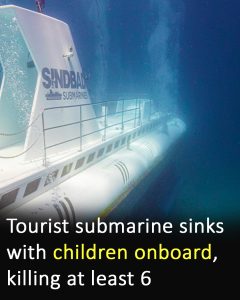A devastating tragedy unfolded in the Red Sea off the Egyptian coast, leaving behind heartbreak and questions. A tourist submarine carrying around 44 passengers — including children and tourists of different nationalities — tragically sank during what was meant to be an unforgettable excursion to explore the coral reefs near Hurghada, a popular tourist destination. The incident has resulted in multiple fatalities and prompted a large-scale emergency response.

According to the Egyptian newspaper Al-Masry Al-Youm, the submarine involved in the accident was the Sindbad, a well-known vessel operating in the Hurghada region. On Thursday, it was preparing to take tourists on one of its signature underwater trips, giving them a rare, up-close look at the Red Sea’s colorful coral formations and rich marine biodiversity. However, the excursion turned into a nightmare when the submarine began to sink unexpectedly near the marina of one of Hurghada’s most renowned hotels.
Initial reports indicate that six people lost their lives and nine others were injured, four of them critically. The remaining 29 passengers were successfully rescued by emergency teams. Egyptian authorities responded swiftly. The Red Sea Health Directorate and the Egyptian Ambulance Authority quickly went on high alert, deploying a fleet of 21 ambulances alongside security and rescue forces to the scene. Their efforts undoubtedly saved lives, but they could not prevent the tragic loss of others.
The Sindbad submarine has been in operation for years, offering underwater excursions to thousands of tourists. According to the company’s official website, it owns two of the world’s only “14 real recreational submarines.” These unique vessels are capable of descending up to 82 feet beneath the sea’s surface, giving passengers a chance to experience the wonders of the deep without the need for diving gear. The trip typically lasts around 40 minutes and includes a photo opportunity with a diver show, after which guests are returned to the marina.
The Sindbad promises both comfort and safety. Its design includes air-conditioning, 44 passenger seats, two pilot seats, and large circular viewing windows to ensure a panoramic view of the underwater world. The company markets the experience as unforgettable and suitable for all ages — an opportunity to enjoy the Red Sea in a safe, enclosed environment. But with this recent disaster, the safety assurances are being called into question.
In the aftermath, conflicting information emerged regarding the identities and nationalities of those who perished. The governor’s office in Hurghada confirmed the deaths of six foreign nationals, although their nationalities were not officially disclosed. Meanwhile, the Russian Embassy in Egypt posted on Facebook that all passengers aboard the submarine were Russian citizens. Interestingly, the embassy only reported four deaths, contradicting the six fatalities confirmed by local authorities. Adding to the tragedy, a Russian Telegram news channel, Baza, reported that one of the deceased was a child.
Hurghada has long been a favored destination among European tourists. Located in Egypt’s Red Sea governorate, it attracted over four million visitors in 2022. The city is well-known for its luxurious beach resorts, crystal-clear waters, and access to pristine coral reefs. German tourists topped the list of international visitors, with 1.158 million arriving that year. Tourists from Russia, the Czech Republic, and Poland also made up a significant portion of travelers to the area.
However, the region’s growing popularity has been accompanied by rising safety concerns — especially when it comes to water-based excursions. Earlier this year, in February, the UK government issued a formal warning concerning liveaboard diving trips in the Red Sea. The advisory came after the Marine Accident Investigation Branch reported 16 incidents over the past five years. Alarmingly, three dive boats had sunk within the last 21 months alone, resulting in several fatalities, including some UK nationals.
The UK government now urges its citizens to exercise caution when booking such excursions, recommending that travelers only use well-established and reputable tour operators who can demonstrate compliance with safety protocols. Tourists are also advised to insist on detailed safety briefings from the crew as soon as they board.
This most recent submarine disaster may further reinforce those warnings. It raises troubling questions about the maintenance, inspection, and emergency preparedness of recreational underwater vehicles operating in popular tourist zones. While the full details of what went wrong aboard the Sindbad are still under investigation, it’s clear that something catastrophic occurred — something that caught passengers, crew, and emergency responders off guard.
Tourist submarine rides, once seen as a safe and family-friendly alternative to scuba diving, may now face new scrutiny. Operators in the Red Sea region — and around the world — may be compelled to revisit their safety procedures, inspection routines, and emergency training for crew members. There will likely be renewed pressure on regulators to enforce stricter compliance with international safety standards.
The Red Sea, long cherished for its beauty and biodiversity, is now the backdrop of a haunting tragedy. For the families of those who lost their lives, the pain is immeasurable. For survivors and emergency responders, the day will never be forgotten. And for the tourism industry in Egypt, this incident is a sobering reminder that even the most magical experiences carry real risks — and those risks must be addressed with the utmost seriousness and care.
As investigations continue, many are hoping for transparency, accountability, and above all, action — so that no other families have to endure the kind of loss witnessed this week in Hurghada’s shimmering waters.





